The Running Chicken Nebula (Lambda Centauri Nebula) is an emission nebula with an open cluster located approximately 6,500 light-years away in the constellation Centaurus. With an apparent magnitude of 4.5 and an apparent size of 75 arcminutes, it can be observed in binoculars and small telescopes. The nebula is listed as IC 2944 in the Index Catalogue and Caldwell 100 in the Caldwell catalogue of deep sky objects visible in amateur telescopes.
The Lambda Centauri Nebula was nicknamed the Running Chicken because some observers find that it has a bird-like shape. However, there is no consensus on which part of the extended nebula complex forms the cosmic Chicken’s head, feet and rear end.
The nebula is a vast region of hydrogen gas and dust populated by young, blue, exceptionally hot stars. The stellar winds and intense ultraviolet radiation from these stars carve and erode the nebular material. At the same time, the ultraviolet light of the young stars energizes the nebula and makes it glow. In a few million years, the most massive of these blue stars will go out as supernovae.
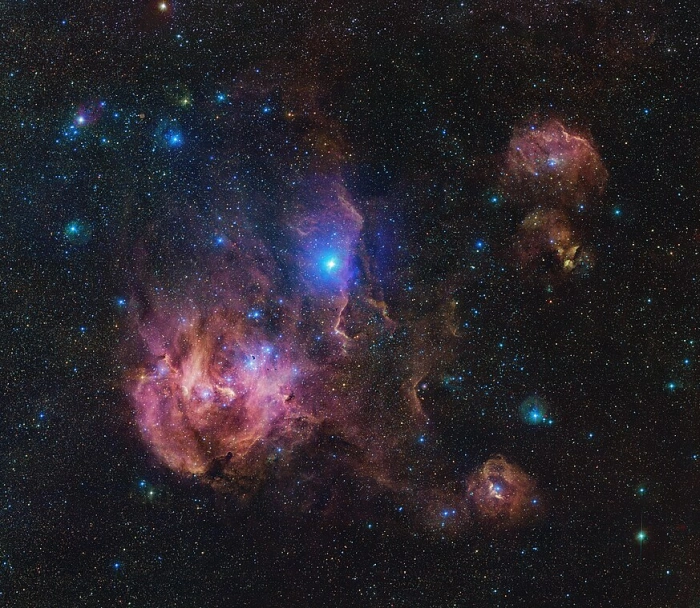
The Running Chicken Nebula comprises several clouds, all of which we can see in this vast image from the VLT Survey Telescope (VST), hosted at ESO’s Paranal site. The clouds shown in wispy pink plumes are full of gas and dust, illuminated by the young and hot stars within them. Credit: ESO/VPHAS+ team; Acknowledgement: CASU (CC BY 4.0)
IC 2944 has a radius of 71 light-years. It is called the Lambda Centauri Nebula because it appears in the same field of view as the star Lambda Centauri in the sky. Lambda Centauri is a hot blue giant (B9 III) located 470 light-years away. It is not related to the Running Chicken in the background. With an apparent magnitude of 3.13, the star is visible to the unaided eye. It is the 10th brightest star in Centaurus.
Lambda Centauri is a similar star to those in the Running Chicken Nebula. It is a member of the Scorpius-Centaurus association, the nearest association of hot, blue O- and B-type stars to the Sun. Like the massive stars in the nebula, Lambda Centauri will have a relatively short life due to its high mass.
The stars of the Running Chicken Nebula are members of the much more distant Crux OB1 stellar association. The Lambda Centauri Cluster (IC 2944) was catalogued as Collinder 249 by the Swedish astronomer Per Collinder in his catalogue of open clusters in 1931.
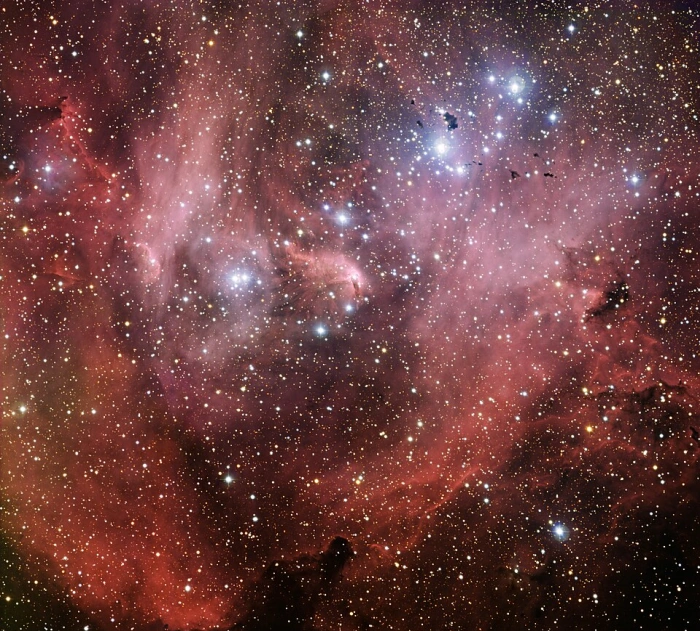
This image from the Wide Field Imager on the MPG/ESO 2.2-metre telescope shows the Running Chicken Nebula, a cloud of gas and newborn stars that lies around 6500 light-years away from us in the constellation of Centaurus (The Centaur). Officially called IC 2944, or the Lambda Centauri Nebula, its strange nickname comes from the bird-like shape of its brightest region. The star Lambda Centauri itself lies just outside the field of view. Image credit: ESO (CC BY 4.0)
IC 2944 was originally the designation of the nebula observed near Lambda Centauri. It was later adopted as the designation of the large HII region that includes both IC 2944 and the brighter IC 2948.
The entire Running Chicken Nebula is a large complex with an apparent size comparable to that of 25 full Moons. IC 2944 appears the closest to the star Lambda Centauri. The brightest portion of the emission nebulosity is designated IC 2948 and lies southeast of IC 2944. It appears only 0.93 arcminutes from IC 2944 and has an angular size of 45 by 40 arcminutes.
The fainter emission nebulae Gum 39 and Gum 40 (IC 2872) appear west of IC 2944, and Gum 41 to the southwest. These nebulae are part of the Running Chicken Nebula complex.
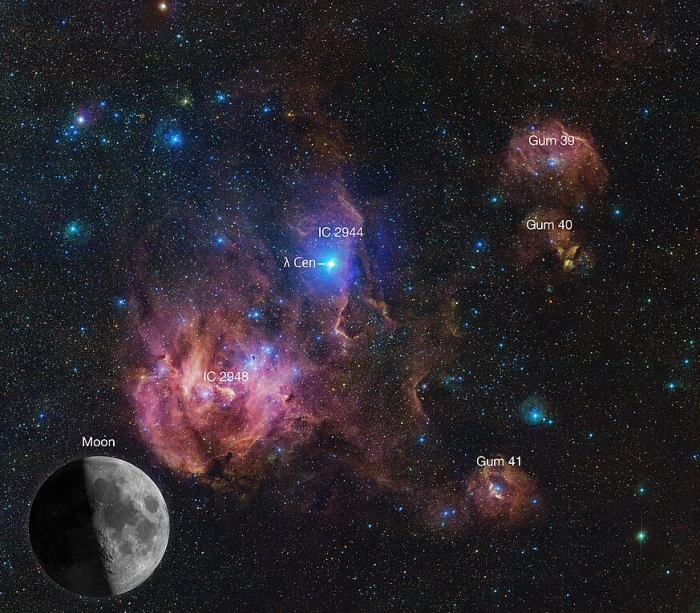
The Lambda Centauri Nebula (Caldwell 100), image credit: SO/VPHAS+ team; Acknowledgement: CASU (CC BY 4.0)
Gum 39 and Gum 40 are generally taken to be the chicken’s head and wattles, or alternatively the crest and head. Most observers see Gum 41 as the foot, but some see it as the head. Others consider the nebula’s brightest part, IC 2948, to be the head.
Gum 39 is centred around the star HD 99897 (O6.5IV). The hot blue runaway star has a bow shock and lies approximately 6,849 light-years away.
IC 2872 has several lobes, divided by regions of dust. It is separated by 1.88 arcminutes from IC 2944 and has an apparent size of 15 by 6 arcminutes. A bright patch of star formation surrounded by darker clouds is seen by some as the chicken’s beak.
The Lambda Centauri Nebula hosts many Bok globules. These are small, dense nebulae usually associated with star formation. However, observations with the ESO 3.6m telescope and the Schmidt telescope in the 1980s and 1990s did not find evidence of any stars forming in any of the globules.

This intriguing view of a spectacular stellar nursery IC 2944 is being released to celebrate a milestone: 15 years of ESO’s Very Large Telescope. This image also shows a group of thick clouds of dust known as the Thackeray globules silhouetted against the pale pink glowing gas of the nebula. These globules are both being eroded away and also fragmenting, rather like lumps of butter dropped onto a hot frying pan. It is likely that Thackeray’s globules will be destroyed before they can collapse and form new stars. Credit: ESO (CC BY 4.0)
In 1997, astronomers at the European Southern Observatory in Chile reported that there was no evidence of star formation in these pockets of nebulosity and that the globule complex was in a late stage of disintegration. The globules are likely remnants of a larger elephant trunk. They have very different velocities, which indicates that they are a dynamic system with an estimated age of only 1 million years.
The brightest star in the Lambda Centauri Nebula region is the red supergiant V772 Centauri (HD 101712). Most other bright stars in the nebula are hot, blue O- and B-type stars. They include HD 101070, HD 101333, HD 101008, HD 101205 and HD 101131. All these luminous blue stars are fainter than magnitude 7.80 and invisible to the unaided eye.
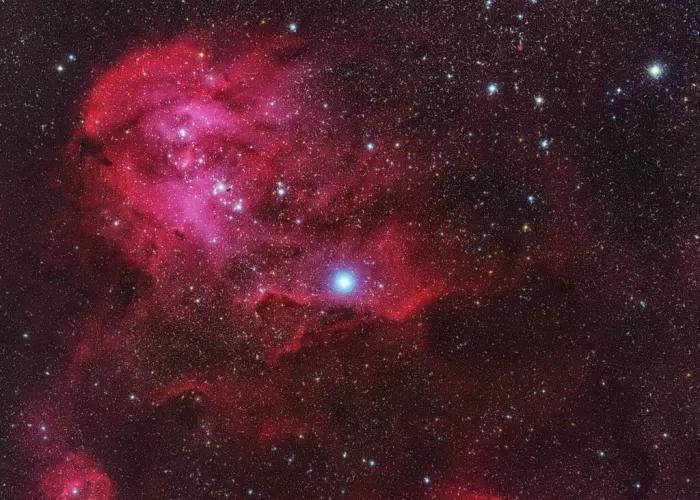
The Lambda Centauri Nebula (IC 2944), also known as the Running Chicken Nebula, is an emission nebula and star-forming region located in the constellation of Centaurus. This image is a combination of both narrowband Hydrogen Alpha data photographed from within a city area, as well as broadband RGB data from a dark sky site. Image credit: Ivan Bok (CC BY 4.0)
Facts
IC 2944, IC 2872 and IC 2948 were discovered by the American astronomer Royal Harwood Frost on May 5, 1904. Frost saw the nebula on a photographic plate taken with the 24-inch Bruce photographic telescope in Arequipa, Peru. He noticed the nebula around Lambda Centauri but not the open cluster associated with it.
The Bok globules in the large southern HII region of the Running Chicken Nebula were discovered by the astronomer A. D. Thackeray in 1950. They are known as Thackeray’s Globules. They lie in the IC 2948 portion of the Lambda Centauri Nebula complex. The images of the nebula taken during the Two Micron All-Sky Survey, or 2MASS, between 1997 and 2001, revealed six stars in the largest Thackeray globule.
Thackeray investigated the Lambda Centauri Nebula in the 1950s and 1960s. In 1965, he conducted a photometric and spectroscopic survey of the open cluster IC 2944 and identified 61 stars down to magnitude 15.
Among the stars with measured radial velocities, he found at least 50 percent binary systems. Thackeray found a true distance of 2 kiloparsecs for the nebula, which is consistent with the currently accepted 6,500 light-years (1.99 kiloparsecs). He identified the red supergiant HD 101712 as the brightest and most certain member of the cluster.
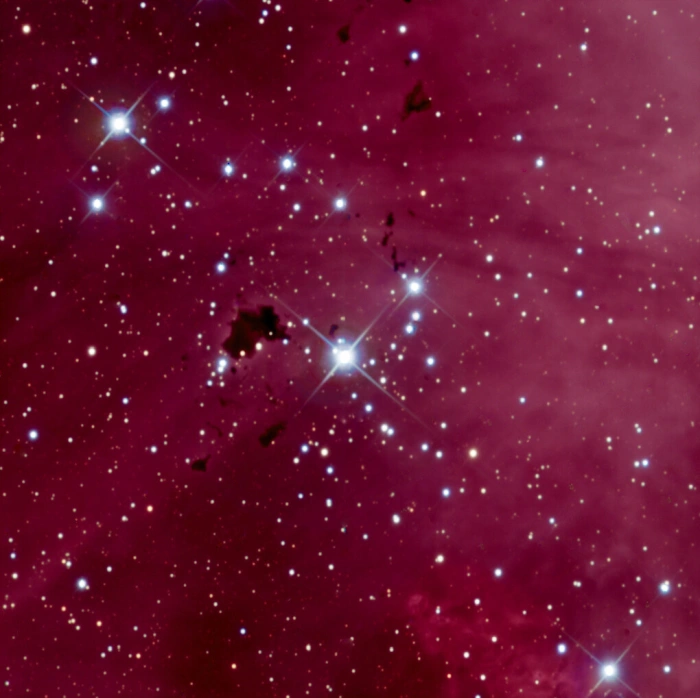
IC 2944 is an emission nebula in Centaurus,. Centaurus contains two of the top ten brightest stars in the universe producing massive quantities of powerful UV radiation. An interesting aspect of this nebula is the presence of dark globules with the eponymn of Thackery’s Globules. These structures represent the remains of a large dark nebula that has been eroded by UV radiation. The globules of dense clumps of gas and dust are nearly 1.4 light years in width, and go by the name of Bok globules. Image credit: SSRO/PROMPT and NOIRLab/NSF/AURA (CC BY 4.0)
Location
The Running Chicken Nebula lies in the constellation Centaurus. The celestial Centaur is one of the largest and brightest constellations in the sky, which makes it easy to locate any deep sky objects within its borders.
The Lambda Centauri Nebula appears in the southernmost part of Centaurus, near the border with Musca (the Fly), Crux (the Southern Cross), and Carina (the Keel). It can be found in the region between the Southern Cross, formed by the brightest stars in the constellation Crux, and the fainter Diamond Cross, formed by Miaplacidus (Beta Carinae) with Theta, Upsilon and Omega Carinae in Carina.
Lambda Centauri represents the western foot of Centaurus. It is the brightest star in the area between Theta Carinae and the Southern Pleiades (IC 2602) and Ginan (Epsilon Crucis), the faintest star of the Southern Cross. IC 2944 appears around Lambda Centauri and the rest of the Running Chicken Nebula lies south of the star.
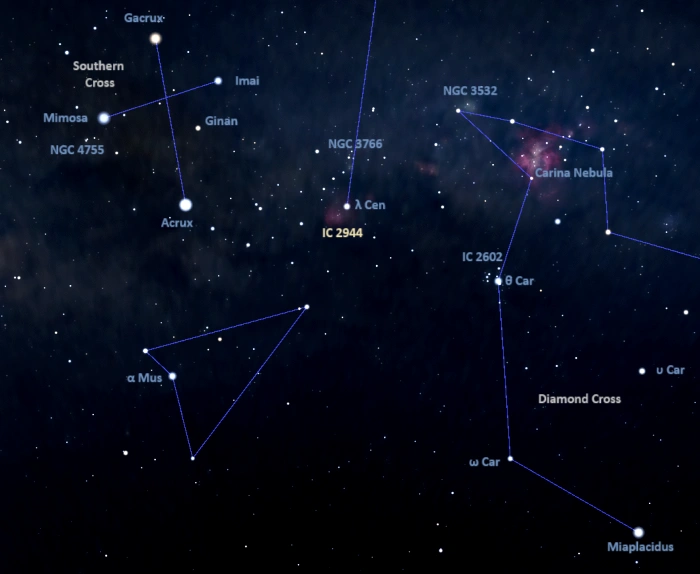
The location of the Running Chicken Nebula (IC 2944), image: Stellarium
At declination -63°, the Lambda Centauri Nebula never rises for observers north of the latitude 26° N and is best seen from the southern hemisphere. It stays close to the horizon for observers in the northern tropical latitudes.
The bright Pearl Cluster (NGC 3766, Caldwell 97) appears in the same area, just north of Lambda Centauri. With an apparent magnitude of 5.3 and an apparent size of 12 arcminutes, the cluster can be observed in binoculars and small telescopes. It lies much closer to us, at a distance of 5,500 light-years, and is part of the Carina molecular cloud complex.
Running Chicken Nebula – IC 2944
| Constellation | Centaurus |
| Object type | Open cluster with emission nebula |
| Right ascension | 11h 38m 20.00s |
| Declination | −63° 22′ 22.0″ |
| Apparent magnitude | 4.5 |
| Apparent size | 75’ |
| Distance | 6,500 light-years (1,993 parsecs) |
| Radius | 71 light-years |
| Names and designations | Running Chicken Nebula, Lambda Centauri Nebula, λ Centauri Nebula, IC 2944, Caldwell 100, C100, Collinder 249, Cr 249, RCW 62, GUM 42, BRAN 362A, C 1134-627, GAL 295.1-01.6, MHR 18, MSH 11-6-05, OCl 862.0, GRS G295.00 -01.70 |
Images
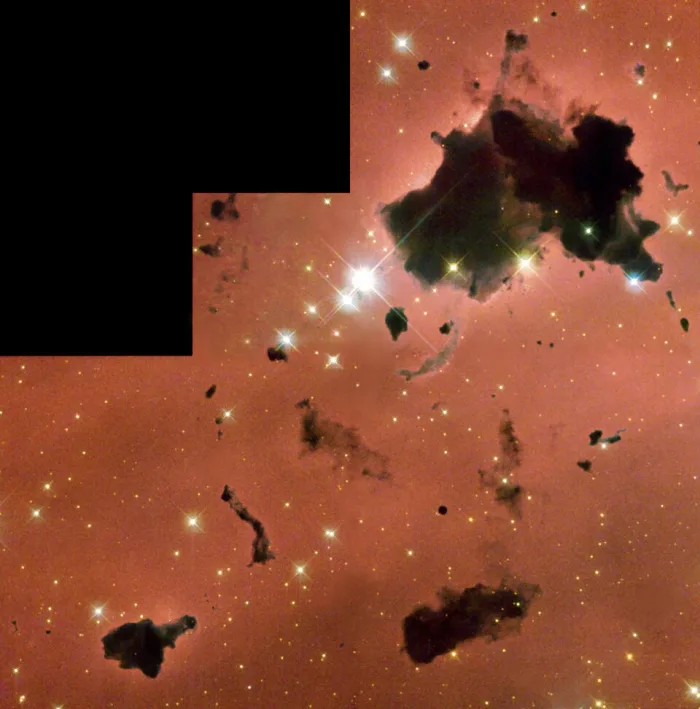
Strangely glowing dark clouds float serenely in this remarkable and beautiful image taken with the Hubble Space Telescope. These dense, opaque dust clouds — known as globules — are silhouetted against nearby bright stars in the busy star-forming region, IC 2944. Astronomer A.D. Thackeray first spied the globules in IC 2944 in 1950. Globules like these have been known since Dutch-American astronomer Bart Bok first drew attention to such objects in 1947. But astronomers still know very little about their origin and nature, except that they are generally associated with areas of star formation, called HII regions due to the presence of hydrogen gas. IC 2944 is filled with gas and dust that is illuminated and heated by a loose cluster of massive stars. These stars are much hotter and much more massive than our Sun. Image credit: NASA and The Hubble Heritage Team (STScI/AURA); Acknowledgment: Bo Reipurth (University of Hawaii) (PD)
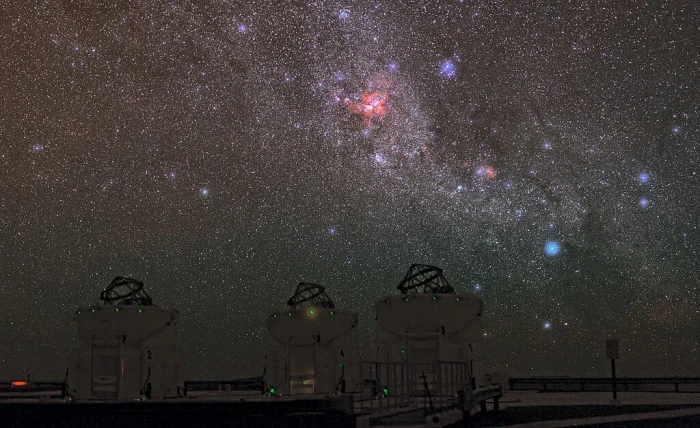
ESO Photo Ambassador, Babak Tafreshi has captured an outstanding image of the sky over ESO’s Paranal Observatory, with a treasury of deep-sky objects. The most obvious of these is the Carina Nebula, glowing intensely red in the middle of the image. The Carina Nebula lies in the constellation of Carina (The Keel), about 7500 light-years from Earth. This cloud of glowing gas and dust is the brightest nebula in the sky and contains several of the brightest and most massive stars known in the Milky Way, such as Eta Carinae. Below the Carina Nebula, we see the Wishing Well Cluster (NGC 3532). This open cluster of young stars was named because, through a telescope’s eyepiece, it looks like a handful of silver coins twinkling at the bottom of a wishing well. Further to the right, we find the Lambda Centauri Nebula (IC 2944), a cloud of glowing hydrogen and newborn stars which is sometimes nicknamed the Running Chicken Nebula, from a bird-like shape that some people see in its brightest region. Above this nebula and slightly to the left we find the Southern Pleiades (IC 2632), an open cluster of stars that is similar to its more familiar northern namesake. In the foreground, we see three of the four Auxiliary Telescopes (ATs) of the Very Large Telescope Interferometer (VLTI). Credit: ESO/B. Tafreshi (twanight.org) (CC BY 4.0)

Even though it looks stunning by itself, this Picture of the Week is actually only a tiny part of a 1.5-billion-pixel image of the Running Chicken Nebula. It forms the comb on the running chicken’s head — at least according to some people, because everyone seems to see a different chicken! The data for this gigantic image was captured by the VLT Survey Telescope (VST), a facility of the Italian National Institute for Astrophysics hosted and operated by ESO. But for now, let’s zoom back in on GUM 39, as this nebula is officially called. All around the nebula, orange, white and blue stars are dotting the sky like fireworks. The pink glow that you see are fumes of hydrogen gas, illuminated by the intense radiation from newborn stars. The nebula is also crossed by dark lanes of cosmic dust that block the light behind them. Nebulae like this are also called stellar nurseries, because as these dense clouds of molecular gas gravitationally collapse they give birth to plenty of new stars. With telescopes like the VST and ALMA, scientists observe these nebulae to get a better understanding of the complex process of how stars are born. Image credit: ESO/VPHAS+ survey (CC BY 4.0)
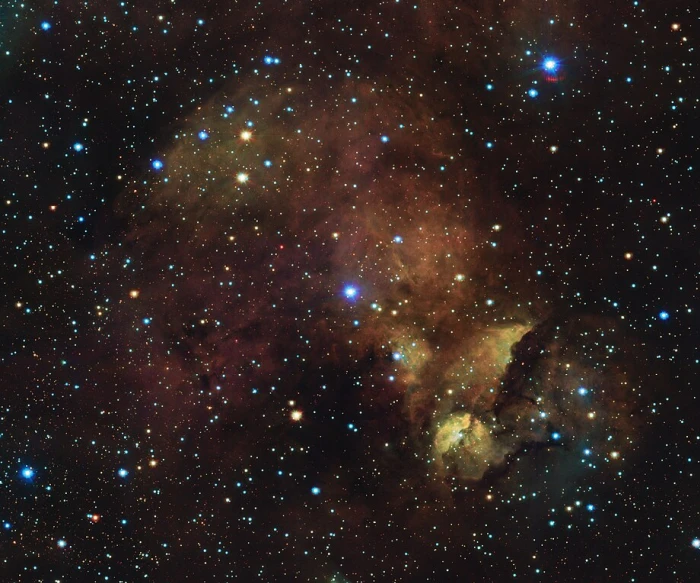
This image of IC 2872 — or Gum 40, the chicken head or whatever nickname you might wish to give it — was captured by the VLT Survey Telescope (VST), hosted at ESO’s Paranal Observatory in Chile. Image credit: ESO/VPHAS+ survey (CC BY 4.0)
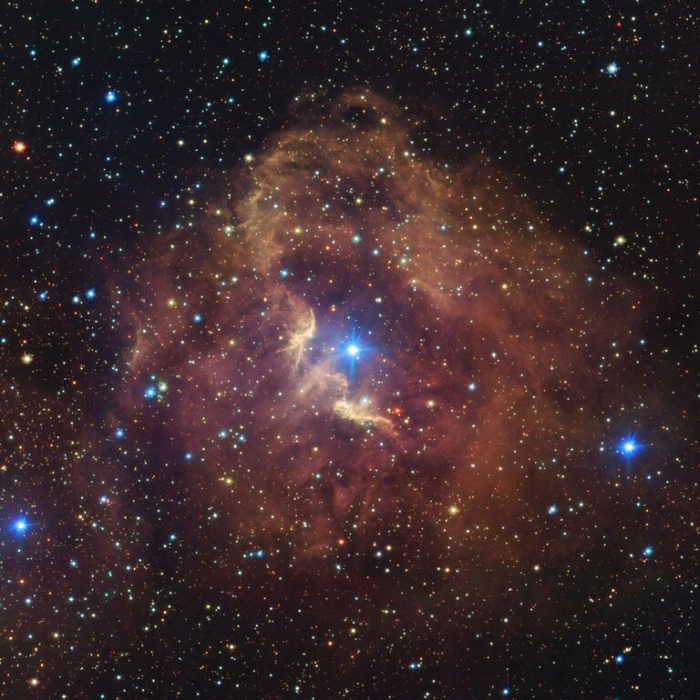
Located in the picturesque southern constellation of Centaurus, the Gum 41 nebula takes up most of this image brought to you by the VLT Survey Telescope, hosted at ESO’s Paranal Observatory in Chile. Let’s take a closer look at this intricate structure. Set against a colorful backdrop of stars, Gum 41 is a pleasantly symmetric example of a Strömgren sphere: a shell of hydrogen gas atoms glowing in rosy hues due to the radiation of the dazzling central star. While this star, called HD 100099, may appear to be one very bright object, it is actually thought to be two young, massive stars orbiting in such a tight embrace that they cannot be separated at the scale of this image. This romantic region is home to many pairs like this, including the luminous object on the lower right outskirts of the nebula, HD 99944. Sadly, the love story in these stellar couples will have a tragic ending: unlike our Sun, these hot and massive stars tend to have short lifetimes of only a few million years, and eventually there will be no young stars left to make the nebula glow. Credit: ESO/VPHAS+ team. Acknowlegement: CASU (CC BY 4.0)
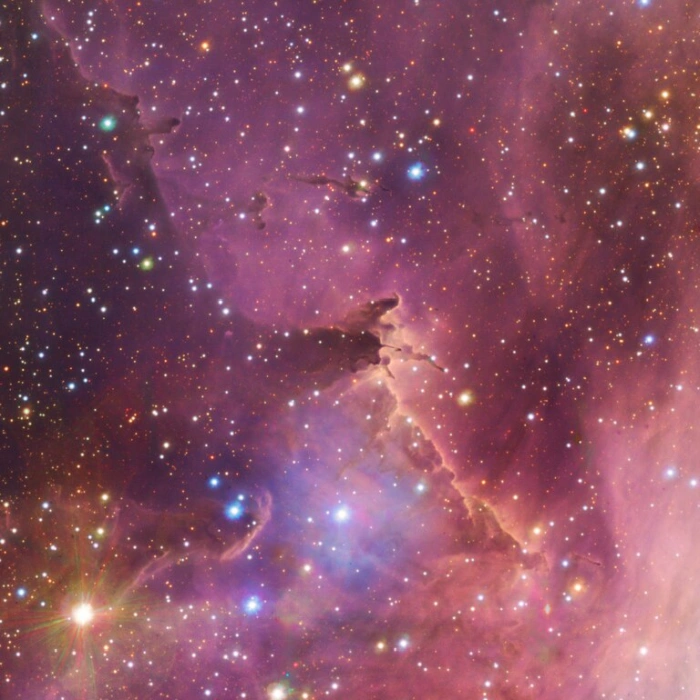
The gas cloud IC 2948 is the brightest region of the Running Chicken Nebula. Here, we find creeping dark clouds, shaped like open hands about to grab their surrounding blooming stars. First discovered more than a century ago, this gas cloud is helping us understand how stars form and behave during their infancy. To spot IC 2948 within the much larger Running Chicken Nebula, locate the chicken’s rear end (or its head, as some people claim). Image credit: ESO/VPHAS+ team. Acknowledgement: CASU (CC BY 4.0)
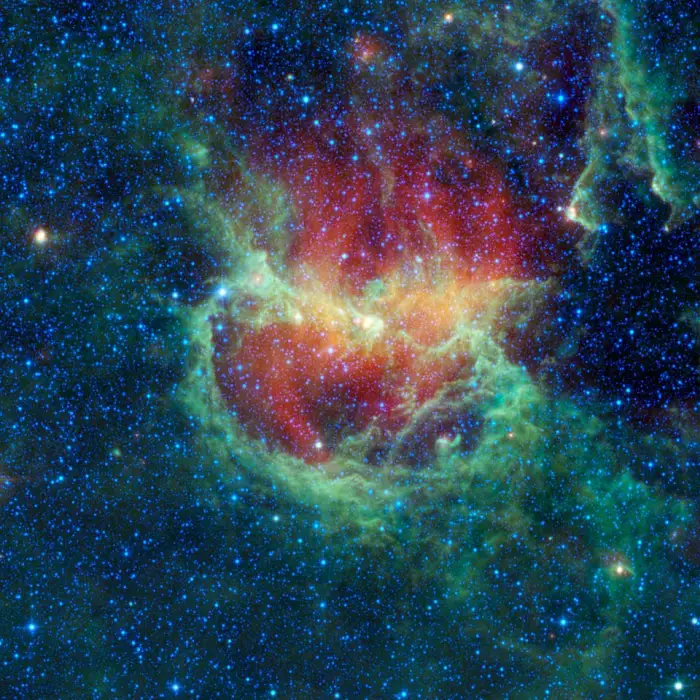
This infrared image from NASA’s Wide-field Infrared Survey Explorer, or WISE, shows the Lambda Centauri nebula, a star-forming cloud in our Milky Way galaxy, also known as the Running Chicken nebula. The nebula, cataloged as IC 2944, is home to a new cluster of stars born from the cloud nearly 8 million years ago. The hottest members of the cluster produce enough ultraviolet radiation and strong winds to convert the cloud into ions and excavate it. The ionized gas glows in visible light, but in infrared light we see the dust in the cloud warmed by the very same radiation. The red, glowing dust is the coolest material visible in this image and is composed of metallic dust grains. The greenish components in the image are warmer dust grains composed of smog-like materials. The large green ring-like structure near the middle of the image is some 77 light-years across and was formed when materials that created the stars in the clusters were blown back by the combined winds of the stars. Image credit: NASA/JPL-Caltech/UCLA (PD)

This image was obtained with the wide-field view of the Mosaic II camera on the Blanco 4-meter telescope at Cerro Tololo Interamerican Observatory on January 12th and February 7th, 2012. An array of dark Bok globules, known as Thackeray’s Globules, can be seen in silhouette against the emission nebula IC 2944 in the constellation Centaurus. The image was generated with observations in the B (blue), I (orange) and Hydrogen-Alpha (yellow) filters. Image credit: T.A. Rector (University of Alaska Anchorage) and N.S. van der Bliek (NOIRLab/NSF/AURA) (CC BY 4.0)